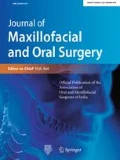Abstract
Introduction
The purpose of this study was to compare the outcome of open treatment of mandibular fracture (symphysis or parasymphysis) using lag screw or mini plate clinically as well as radiologically in young (age range 12–45 years) and healthy individuals of poor socioeconomic status.
Method
This prospective study was conducted on 30 patients diagnosed as cases of displaced mandibular anterior fractures treated with open reduction and internal fixation. The patients were then randomly allocated to either of two groups––Group A: Two 2.5 mm stainless steel lag screws were placed in 15 patients. Group B: Two 2.5 mm stainless steel mini plates were placed in 15 patients for the fixation of fractures. Subsequent follow up was done on 2nd, 4th, 6th and 8th week postoperatively. During every follow up patient was assessed clinically for infection, malocclusion, loosening of plate/screw, sensory disturbance, plate fracture, malunion/non-union, devitalisation of associated dentoalveolar segment and masticatory efficiency. Radiographs were taken if necessary and patients were further assessed for any complaint. Pain was objectively measured using a visual analogue scale, bite force was measured using a bite force transducer at biweekly interval. The data collected was subjected to unpaired t test and paired t test for statistical analysis.
Results
During follow up period a significant improvement in bite force was present in both the groups, with more improvement seen in the lag screw group (p < 0.01). There was a significant pain reduction present in the lag screw group (p < 0.01) and also masticatory efficiency showed a steadier improvement in lag screw group while mini plate group patients showed a tendency to masticate only food items of medium hard consistency.
Conclusion
The sample size is small to conclude lag screws are better than mini plates but the result of our study provides a basis for further studies done to conclude that the application of LAG SCREW is an effective, inexpensive, quick treatment modality to accelerate healing of fresh, displaced mandibular anterior fracture.




Similar content being viewed by others
References
Miloro M, Ghali GE, Larsen PE, Waite PD (2004) Principles of oral and maxillofacial surgery, 2nd edn. BC Decker Inc Hamilton, London, pp 371–382
Thaller SR, McDonald SW (2005) Facial trauma, 1st edn. Marceld Ekkek Inc, New York, pp 381–414
Tiwana PS, Kushner GM, Alpert B (2007) Lag screw fixation of anterior mandibular fractures: a retrospective analysis of intraoperative and postoperative complications. J Oral Maxillofac Surg 65:1180–1185
Madsen MJ, Mcdaniel CA, Haug RH (2008) A biomechanical evaluation of plating techniques used for reconstructing mandibular symphysis/parasymphysis fracture. J Oral Maxillofac Surg 66:2012–2019
Harle F, Champy M, Terry BC (1999) Atlas of craniomaxillofacial osteosynthesis. Thieme Stuttgart, New York, pp 3–53
Leonard MS (1987) The use of lag screws in mandibular fractures. Otolaryngol Clin North America 20(3):479–493
Ellis E, Muniz O, Anand K (2003) Treatment considerations for comminuted mandibular fractures. J Oral Maxillofac Surg 61:861–870
Schaaf H, Kaubruegge S (2011) Comparison of miniplate versus lag screw for fractures of the mandibular angle. Oral Surg Oral Med Oral Pathol Oral Radiol Endod 111:34–40
Worthington P, Champy M (1987) Monocotical miniplate osteosynthesis. Otolaryngol clin North America 20(3):607–620
Kallela I, llzuka T, Laine P, Lindqvist C (1996) Lag-screw fixation of mandibular parasymphyseal and angle fractures. Oral Surg Oral Med Oral Pathol Oral Radiol Endod 81:510–516
Wang H, Baohui Ji, Jiang W (2010) Three-dimensional finite element analysis of mechanical stress in symphyseal fractured human mandible reduced with miniplates during mastication. J Oral Maxillofac Surg 68:1585–1592
Gerlach KL, Schwarz A (2002) Bite forces in patients after treatment of mandibular angle fractures with miniplate osteosynthesis according to Champy. Int J Oral Maxillofac Surg 31:345–348
Author information
Authors and Affiliations
Corresponding author
Rights and permissions
About this article
Cite this article
Bhatnagar, A., Bansal, V., Kumar, S. et al. Comparative Analysis of Osteosynthesis of Mandibular Anterior Fractures Following Open Reduction Using ‘Stainless Steel Lag Screws and Mini Plates’. J. Maxillofac. Oral Surg. 12, 133–139 (2013). https://doi.org/10.1007/s12663-012-0397-z
Received:
Accepted:
Published:
Issue Date:
DOI: https://doi.org/10.1007/s12663-012-0397-z




